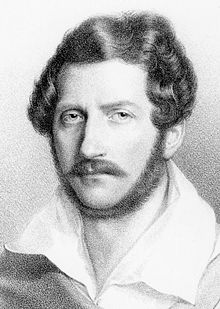- Marino Faliero (opera)
-
Marino Faliero (or Marin Faliero) is a tragedia lirica, or tragic opera, in three acts by Gaetano Donizetti. Giovanni Emanuele Bidéra wrote the Italian libretto, with revisions by Agostino Ruffini, after Casimir Delavigne's play. It is inspired by Lord Byron's drama Marino Faliero (1820) and based on the life of Marino Faliero (c.1285-1355), the Venetian Doge.[1]
Rossini had commissioned both Donizetti and Vincenzo Bellini to write operas for the Théâtre-Italien in Paris. Bellini's contribution was the hugely successful I puritani. Donizetti's opera, which premiered on March 12, 1835 (a few months after I puritani) was not nearly as much of a success. Still Marino Faliero was presented in London that same year and at the Teatro Alfieri in Florence in 1836. It also marked Donizetti's first opera to have its premiere in Paris.
Contents
Roles
Role Voice type Premiere Cast, 12 March 1835
(Conductor: - )Marin Faliero, the Doge of Venice bass Luigi Lablache Israele Bertucci, chief of the Venetian Arsenal baritone Antonio Tamburini Fernando, Faliero's friend and in love with Elena tenor Giovanni Battista Rubini Steno, member of the Council of Forty bass Leoni, Member of the Council of Ten tenor Elena, The Doge's wife soprano Giulia Grisi Irene, Elena's servant soprano Vincenzo, the Doge's servant tenor Beltrame, a sculptor bass Pietro, a gondolier bass Nicolay Ivanov Guido, a fisherman bass Gentlemen, knights, craftsmen, fishermen, servants, soldiers Synopsis
- Place: Venice
- Time: 1355
Elena, the wife of Marin Faliero, Doge of Venice, is continually subjected to attacks on her reputation by the patrician Steno whose advances she has rejected. Steno then insults Israele Bertucci, the chief of the Venetian Arsenal in front of his workers. Steno is punished for these offenses, but Faliero is infuriated by the leniency of the punishment. Israele convinces Faliero to join a conspiracy against the Council of Forty, of which Steno is a member.
Meanwhile, Elena is in love with Faliero's friend Fernando, who wants to leave the city to save her from dishonour. During a masked ball, Fernando challenges Steno to a duel for having insulted Elena once again. When Fernando is found dying in the place where the conspirators were to meet, Faliero vows to avenge his death.
The conspiracy collapses following a betrayal by one of its members and the Doge is condemned to death. Before his execution, Elena confesses her love affair with Fernando to him. Faliero begins to curse her, but sensing that his death is imminent, pardons her instead. Faliero is led off. Alone on the stage, Elena hears the sound of the executioner's axe, screams and faints.[2]
Recordings
Year Cast:
Marino Faliero, Israele Bertucci, Fernando, ElenaConductor,
Opera House and OrchestraLabel[3] 1976 Cesare Siepi,
Licinio Montefusco,
Giuliano Ciannella,
Marisa GalvanyElio Boncompagni,
RAI Milan Symphony OrchestraAudio CD: Bongiovanni
Cat: 2408/9-2[4];
Myto Records
Cat: MCD 054.3142002 Michele Pertusi,
Roberto Servile,
Rockwell Blake,
Maria DeviaOttavio Dantone,
Orchestra and Chorus of Teatro Regio Parma
(Recording of a performance in Parma, 2 January)Audio CD: House of Opera
Cat: CD 820References
- Notes
- ^ *Casaglia, Gherardo, "12 Marzo 1835", Almanacco Amadeus, 2005. Accessed 2 October 2009 (in Italian).
- ^ Part of this synopsis is a translation from Marin Faliero (opera) on the Italian Wikipedia.
- ^ Recordings of Marino Faliero on operadis-opera-discography.org.uk
- ^ Tom Kaufman, "Mario Faliero", Opera Today online, 31 May 2006
- Sources
- Ashbrook, William, Donizetti and His Operas, Cambridge University Press, 1982, ISBN 052123526X ISBN 0-521-23526-X
- Holden, Amanda (Ed.), The New Penguin Opera Guide, New York: Penguin Putnam, 2001. ISBN 0-140-29312-4
- Osborne, Charles, The Bel Canto Operas of Rossini, Donizetti, and Bellini, Portland, Oregon: Amadeus Press, 1994 ISBN 0931340713
- Weinstock, Herbert, Donizetti and the World of Opera in Italy, Paris, and Vienna in the First Half of the Nineteenth Century, New York: Pantheon Books, 1963. ISBN 63-13703
External links
- Libretto (Italian)
Categories:- Italian-language operas
- Operas by Gaetano Donizetti
- 1825 operas
- Operas
Wikimedia Foundation. 2010.

